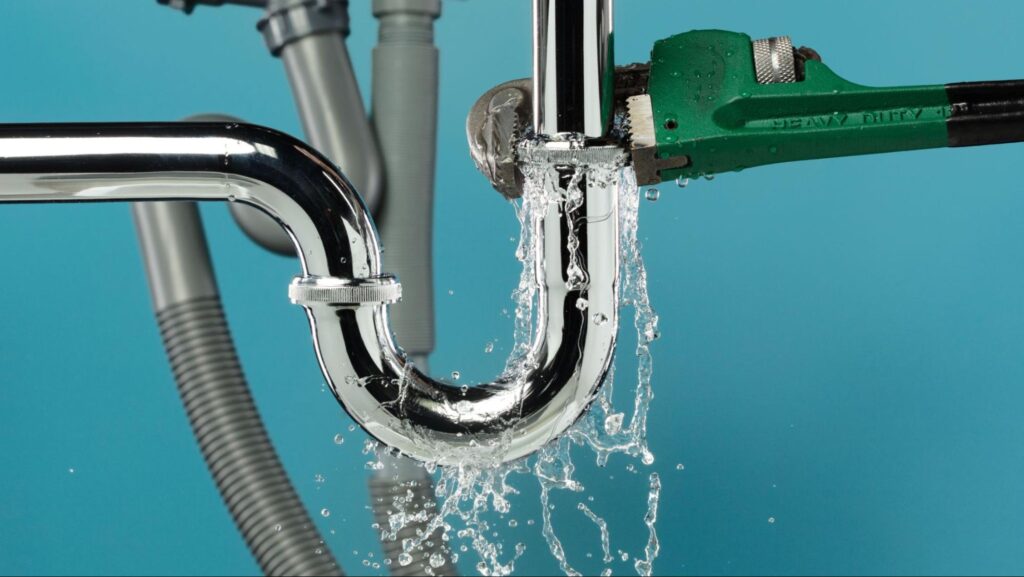Water leaks are one of the most common problems homeowners face. They often start small and go unnoticed until the damage becomes serious. A slow drip or hidden leak can lead to mold, warped floors, damaged ceilings, and expensive repairs. Acting quickly is the best way to prevent water from causing structural damage to your home. This guide explains practical, effective ways to stop a water leak before it gets worse. By learning what signs to look for and how to act fast, you can protect your home and avoid costly repairs.
Know Where to Look First
Not all leaks are visible. Some hide behind walls, under floors, or above ceilings. To stop a leak early, you need to know where water problems usually begin. Common areas include under sinks, around toilets, near washing machines, dishwashers, water heaters, and in basements. Also, check ceilings for stains, walls for peeling paint, or floors that feel damp or spongy.
Outdoor leaks can also cause damage. Look near garden hoses, outdoor spigots, irrigation systems, and gutters. Water can enter your home from the outside if these areas are not sealed properly.
Recognize the Signs Early
Knowing how to stop a water leak begins with recognizing its presence early. Not all leaks are obvious; some start slow and hidden behind walls, under floors, or in inaccessible pipes. Common indicators include damp spots on walls or ceilings, musty odors, unexplained increases in water bills, and sounds of dripping or running water when no faucets are in use.
Water leaks pose serious risks beyond mere inconvenience. Persistent moisture compromises wood framing, drywall, and insulation, leading to rot and weakening structural components. More importantly, trapped moisture creates ideal conditions for mold and mildew, which threaten indoor air quality and human health. Thus, early intervention by learning how to stop a water leak is crucial for damage control and prevention.
Shut Off the Water Supply Immediately
Once you discover a leak, the first and most important step is to stop the water from flowing. You can do this by shutting off the main water valve. This valve is usually found in the basement, crawl space, or near the water meter outside your house. Turn it clockwise to shut it off.
If the leak is limited to a sink, toilet, or washing machine, you can shut off the local valve connected to that fixture. Stopping the water flow gives you time to assess the situation and make repairs without more water adding to the problem.
Find the Exact Source of the Leak
After turning off the water, locate the source of the leak. Sometimes, it’s obvious—like a burst pipe under the sink or water dripping from the ceiling. In other cases, it takes some investigation. Look for wet surfaces, track where the water is coming from, and check pipes, joints, and fixtures.
If you can’t find the source, it may be behind a wall or in the ceiling. In this case, you might need to use a moisture meter to detect hidden dampness or call a professional plumber to help locate the problem.
Temporary Fixes That Work
Once you find the leak, apply a temporary fix to reduce damage until a permanent repair can be made. If you’re trying to learn how to stop a water leak quickly and effectively, these simple solutions can make a big difference:
- Pipe repair tape: Wrap this waterproof tape tightly around small cracks or pinholes in pipes. It can hold for several days while you prepare a long-term solution.
- Pipe clamps: These work for larger leaks in metal or plastic pipes. They provide strong pressure to seal the damaged area.
- Epoxy putty: This moldable compound sticks to metal and plastic and hardens in place to plug leaks.
- Rubber and hose clamps: For quick DIY patches, wrap a piece of rubber (like from an old garden hose) around the leak and secure it with hose clamps.

These temporary methods are simple to apply and stop water from causing further damage while you plan a lasting repair. Understanding how to stop a water leak with these tools gives you a head start on preventing serious water damage.
When to Call a Professional
While DIY methods for how to stop a water leak are helpful, some situations demand expert intervention. Complex leaks inside walls, under slabs, or in main supply lines may require specialized tools and skills. Professional plumbers can assess the system comprehensively, recommend the best repair methods, and ensure the problem is fully resolved.
Professionals also provide long-term solutions like pipe relining, replacement, or upgrading fixtures to more durable options. Early consultation with a plumber when water leaks are suspected prevents costly emergency repairs down the line.
Prevent Future Water Leaks
Prevention is the most effective strategy for avoiding water damage. Regular checks and maintenance go a long way toward keeping your home safe. Here’s how to reduce the chances of leaks:
- Inspect pipes and hoses regularly: Look under sinks and behind appliances for wear, rust, or cracks.
- Replace old plumbing parts: Rubber washers, seals, and hoses degrade over time. Replace them before they fail.
- Use water leak detectors: Place smart sensors near water heaters, washing machines, or under sinks. These devices send alerts to your phone if they detect moisture.
- Insulate exposed pipes: In colder climates, frozen pipes can burst. Insulation keeps them warm and reduces that risk.
- Don’t ignore small drips: Fixing a dripping faucet or running toilet saves water and can prevent future leaks.
By keeping an eye on your plumbing and acting quickly when you notice problems, you can stop most leaks before they become expensive repairs.
Learn How to Stop a Water Leak with Simple Tools
Learning how to stop a water leak is easier than most people think. You don’t always need a plumber right away. Basic tools and a little know-how can keep damage from spreading. Make sure you have a water shut-off key, pipe repair tape, wrenches, pliers, and a flashlight in an easy-to-access spot in your home.
Even watching a few short videos online can teach you how to apply repair tape or shut off valves. When you have the right tools and some basic knowledge, you can respond fast when a leak starts.
Be Proactive With Routine Maintenance
Routine maintenance checks help you catch small leaks early. Schedule time every season to look at plumbing lines, water heaters, and appliances. Check under cabinets and around your foundation for moisture. Flush your water heater annually to prevent sediment buildup, which can cause leaks at the bottom of the tank.
If you live in an older home, consider having a plumber inspect your plumbing system every few years. Older pipes made from steel or iron are more likely to corrode and leak over time.
Protect Your Home With Smart Technology
Technology has made it easier to prevent water leaks. Smart water sensors, leak detectors, and auto-shutoff valves can give you an edge in protecting your home. These devices connect to your phone and alert you if they sense water in places it shouldn’t be. Some systems even shut off the main water valve automatically.
Here are some smart tools that can help:
- Smart leak detectors: Placed in leak-prone areas, they notify you the moment moisture is detected.
- Water shutoff systems: These systems monitor water usage and close the valve automatically if they detect irregular flow.
- Smart thermostats with humidity sensors: These can alert you to unexpected moisture in the air, which could indicate a hidden leak.
Using smart tech gives you more control and peace of mind, especially if you’re away from home for extended periods.
Understand the Cost of Waiting
Delaying action on a leak—no matter how small—can become expensive. Water damage repair costs can reach thousands of dollars. Mold removal, drywall replacement, floor repairs, and structural work often follow even a minor leak if it isn’t fixed quickly.

Besides the cost, hidden leaks can also affect your health. Mold and mildew grow in damp spaces, and their spores can cause allergies, respiratory issues, and long-term health problems.
It’s much cheaper and easier to take quick action when a leak starts than to pay for major repairs later. Protecting your home starts with staying alert and responding fast.
Insurance and Water Leaks
Many homeowners assume their insurance will cover any water damage. That’s not always the case. Most standard policies cover sudden leaks (like a burst pipe), but they usually don’t pay for damage caused by long-term leaks or poor maintenance. Insurance companies expect homeowners to take care of routine upkeep.
To protect yourself, read your policy carefully and make sure you understand what types of water damage are covered. Taking preventive steps—such as installing leak detectors and doing regular checks—can also help your case if you ever need to file a claim.
Final Thoughts
Water leaks don’t always start with a flood. They often begin as tiny drips or moisture in hidden areas. But left alone, even small leaks can lead to serious damage. The key to avoiding major problems is speed. Act quickly, shut off the water, find the source, and use temporary fixes until you can make permanent repairs.
Knowing how to stop a water leak puts you in control. With some basic tools, regular maintenance, and a watchful eye, you can stop leaks before they grow into disasters. Don’t wait until you see water stains on the ceiling or feel dampness underfoot—take action now to keep your home dry and safe.



